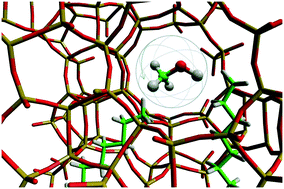
Authors (11): S. K. Matam, A. J. O'Malley, C. R. A. Catlow, Suwardiyanto, P. Collier, A. P. Hawkins, A. Zachariou, D. Lennon, I. P. Silverwood, S. F. Parker, R. F. Howe
Themes: Design DOI: 10.1039/c8cy00422f
Citations: 28
Pub type: article-journal
Pub year: 2018
Publisher: Royal Society of Chemistry (RSC)
Issue: 13
License: http://creativecommons.org/licenses/by/3.0/
Publication date(s): 2018 (online)
Pages: 3304-3312
Volume: 8 Issue: 13
Journal: Catalysis Science & Technology
Link: http://pubs.rsc.org/en/content/articlepdf/2018/CY/C8CY00422F
URL: http://dx.doi.org/10.1039/C8CY00422F
We analyse the dynamics of methanol in ZSM-5 catalysts both with and without the hydrocarbon pool, resulting from the methanol to gasoline (MTG) reaction taking place at 623 K and 673 K for three days, to determine the effects of catalyst use on molecular mobility. Using quasielastic neutron scattering (QENS), we observe that methanol is immobile on the QENS instrumental time scale in the fresh catalyst (ZSM-5-F) and in the sample used to convert methanol for 3 days at 623 K (ZSM-5-623). However, in zeolite ZSM-5-673 (MTG at 673 K for 3 days) we observe isotropic methanol rotation with an immobile fraction of 0.58 and a rotational diffusion coefficient of DR = 3 × 1010 s−1. The observed differences between the zeolites in methanol dynamics are attributed to the development of mesoporosity in ZSM-5-673 due to the high reaction temperature of 673 K, leading to dislodgement of lattice Al as is evident from NMR data.
There are no objects associated to this publication
<< Previous Back Next >>